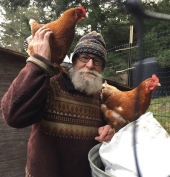Yes, you can have some soft Svevo if you want. Tell me how to go about that. I'm 45 minutes east of Pullman, WA. Higher, colder, overall drier than the Willamette Valley. I'm at 2700 ft elevation. Wheat is grown from Pullman to my place and even a little further east of me, but then it turns into forest land. I'm piecing together what you've said and what Michael wrote... that the Pacific NW is home to soft white wheat, because it grows best there?
RE: Soft Svevo, I am sending you a Purple moosage.
The Willamette Valley is basically part of the Maritime PNW. It is warmer at all points of the year than my maritime location near the Canadian border-- very noticeable in terms of heat accumulation and nighttime temperatures in the growing season. Neither environment is much like the inland NW east of the Cascade mountains.
I am reluctant to say "grows best there". Perhaps "grows well enough most years". Soft White Wheat--SWW-- is grown many places in the inland NW as a consequence physical environment, disease pressure, economics, access to distribution, and historical issues.
True, there are many kinds of pasta. Each pasta type is best accepted if made with flour of specific qualities. One way to accomplish that is to blend flour from different wheats. There will not be a static proportion as a variety of wheat will have different qualities when grown in different years or different environments.





